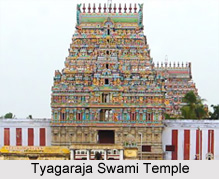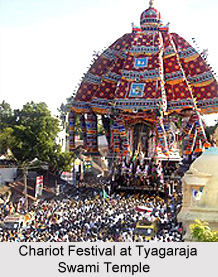 Tyagaraja Swami Temple is a Hindu temple dedicated to Lord Shiva. The temple is located in the town of Thiruvarur near Kumbakonam at Tamil Nadu. Though Sri Valmikanathaswamy is the principal deity, the temple derives its name from Lord Tyagaraja who is unique to this temple. Lord Tyagaraja is in the form of Somaskanda, a composite image of Lord Siva, Sri Uma and Lord Subramanya made by Lord Vishnu.
Tyagaraja Swami Temple is a Hindu temple dedicated to Lord Shiva. The temple is located in the town of Thiruvarur near Kumbakonam at Tamil Nadu. Though Sri Valmikanathaswamy is the principal deity, the temple derives its name from Lord Tyagaraja who is unique to this temple. Lord Tyagaraja is in the form of Somaskanda, a composite image of Lord Siva, Sri Uma and Lord Subramanya made by Lord Vishnu.
It is one of the most sacred temples in the Saivite traditions, its origins lies in antiquity. However, it is definitely known to have existed about 1300 years ago. The famous Kamalalayam tank, and the big temple car which weighs 300 tonne when fully decorated, add to the glory of Thiruvarur. This temple holds the record of having maximum number of shrines in India.
Legend of Tyagaraja Swami Temple
Legend has it that Lord Vishnu, to redeem himself from the curse by Goddess Parvati, whom he had failed to honour, created Sri Somaskanda and worshipped him and got rid of the curse. He was keeping this image on his chest and it was called "Sri Tyagaraja". As he inhaled and exhaled, Sri Tyagaraja image on the chest moved up and down and this became the "Ajapa" dance of Sri Tyagaraja.
Later Lord Vishnu presented this image to Lord Indra, head of Devas. Muchukunda, a great Chola King saved Indra and Devas from Asuras. Indra wanted to present a gift to Muchukunda as a token of gratitude. Muchukunda wanted Sri Tyagaraja image with Indra. Indra created 6 images of Sri Tyagaraja like the original one and asked Muchukunda to choose the original one by placing the 7 images before him. Muchukunda chose the right one by his divine power. Muchukunda was given all the 7 images. Muchukunda came to his capital - Thiruvarur and installed the original image of Sri Tyagaraja and the other 6 images at Tirunallar, Nagapattinam, Thirukaravasal, Thiruvaimoor, Vedaranyam and Thirukuvalai. These 7 places are called "Saptha Vidanga Sthalams" of Sri Tyagaraja and are called by various names in these places and various forms of dances were attributed to them.
History of Tyagaraja Swami Temple
 The temple dates back to the time of the Medieval Cholas. An inscription dated in the period of Rajendra Chola I (1012-1044) is found on the north and west walls of the shrine. It records that the temple was built in stone by Anukkiyar Paravai Nangaiyar. The temple complex seems to have acted as the cultural model for the big "Brihadeswarar Temple" at Thanjavur of Rajaraja Chola I.
The temple dates back to the time of the Medieval Cholas. An inscription dated in the period of Rajendra Chola I (1012-1044) is found on the north and west walls of the shrine. It records that the temple was built in stone by Anukkiyar Paravai Nangaiyar. The temple complex seems to have acted as the cultural model for the big "Brihadeswarar Temple" at Thanjavur of Rajaraja Chola I.
Structure of Tyagaraja Swami Temple
The temple complex covers 30 acres with the "Kamalalayam Tank" to its west, and is one of the largest in India. It houses 4 gateway towers known as "Gopurams". The pillars and the halls here are of great beauty. The temple has numerous shrines, with those of "Tyagaraja" and "Neelothbalambal" being the most prominent. Some of the major shrines in the temple are of "Aananthiswarar", "Neelothmbal", "Asaleswarar", "Adageswarar", "Varuneswarar", "Annamalieswarar" and "Kamalambal".
The present masonry structure was built during the Chola Dynasty in the 9th century, while later expansions are attributed to Vijayanagar rulers of the Sangama Dynasty, the Saluva Dynasty and the Tuluva Dynasty. The temple is maintained and administered by the Hindu Religious and Endowment Board of the Government of Tamil Nadu.
Chariot Festival at Tyagaraja Swami Temple
The temple has the largest chariot in Tamil Nadu and the annual festival is celebrated during the month of April. The chariot is the largest of its kind in Asia and India weighing 300 tonne with a height of 90 feet. The chariot comes around the four main streets surrounding the temple during the festival. The event is attended by lakhs of people from all over Tamil Nadu. The chariot festival is followed by the "Theppam", meaning float festival.
Kulothunga Chola II (1133-50 CE) enlarged the temple ritual to have 56 festivals, some of which are followed in modern times. The foot of Tyagaraja is shown twice a year and on other occasions it is covered with flowers. The left leg of the deity is displayed during "Panguniuthram" festival and right leg on "Thiruvathirai".











